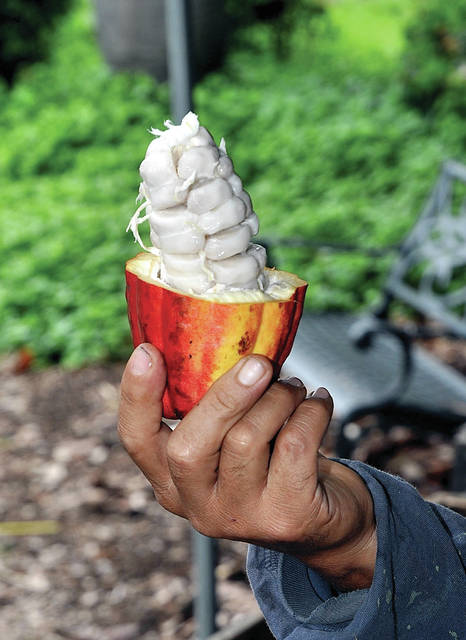Mark your calendar for the Big Island Chocolate Festival April 27-28 at the Hapuna Resort to learn everything from growing to eating cacao or chocolate. For details, check it out online at bigislandchocolatefestival.com.
We sometimes think of mood enhancing drugs with trepidation but they have been part of the human condition for thousands of years. For example, chocolate is associated with enhancing romance. Many years ago, cocoa and tea were considered commercial crops in Hawaii, along with coffee. They grew well and produced very good quality, but could not compete on the world market. High labor costs and inadaquate marketing were probably the limiting factors. Even marajuana was grown legally in the past and is being again seriously considered. As we look at potential profitable crops, there are some to consider that most folks would approve. Hawaiian kava and mamake come to mind since they are uniquely associated with Hawaiian culture.
However, as we look at new and interesting ways to garden and farm, we sometimes find a new look at old crops gives us a new perspective. Cacao is one that looks very promising now due to the interest of local farmers, retailers and foodies. They organized to form the Kona Cacao Association and along with many other local organizations are presenting the 2018 Big Island Chocolate Festival. The best part of the festival will be all the fantastic culinary creations available to eat and drink.
Cocoa or Theobroma cacao, as it is known scientifically, is ornamental as well as useful. What Valentine’s Day or Mother’s Day is complete without chocolate?
Cocoa and tea both grow well on the Big Island. Even though cocoa is thought to be native to the Amazon area just north of the equator, it may have been grown in Mexico for thousands of years. In Borneo, there are thousands of acres in production where the climate is warm, steamy and wet like East Hawaii. It is also found in many gardens growing well in Kona, however cocoa plants do not like drying winds or beach locations.
Tea plants may also be found in Big Island gardens. Most folks believe tea is a crop grown in and confined to equatorial countries. This however is a misconception. Tea grows in a wide range of climates and may be grown in areas extending from equatorial to temperate zones. For example, it grows in Southern Russia near the Caucasian mountains on the latitude of 40 degrees N, and in Argentina near the latitude 30 degrees S. It grows well up to 5,000 feet in Kaloko mauka.
Tea belongs to the camellia family. Its correct botanical name is Camellia sinensis, and is closely related to horticultural varieties which bloom magnificently in many home gardens and public parks.
The tea plant is an attractive evergreen shrub native to Assam. There are about 1,000 varieties known which differ in flower and shade of green leaves as well as flavor when brewed.
The stimulating drink was originally used medicinally but since the fifth century has been the chief beverage in China. It became popular in Europe in the 17th century and was America’s chief beverage until the Boston Tea Party.
An alkaloid, like caffeine, and a volatile oil give tea its flavor. Long brewing extracts tannin which is bitter and not considered beneficial.
Locating plants is not easy but once planted and established, maintenance is no trouble. Some nurseries do carry tea and cocoa plants on occasion. These crops are usually grown where labor costs are low. In Hawaii, tea and cocoa are worth considering for a more interesting garden as well as boutique crops like Kona coffee.




